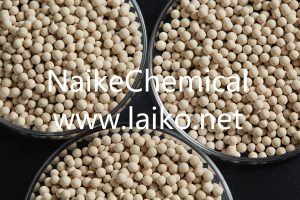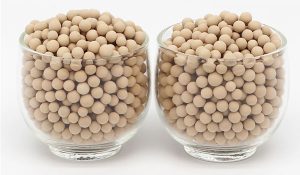How Do Molecular Sieves Remove Water
Molecular sieves have a large surface area, generally 600-1000 square meters per gram. It has a strong adsorption capacity for polarized and polarizable molecules. Water is a strongly polarized molecule, and its molecular diameter is smaller than that of a molecular sieve which is easily absorbed by a molecular sieve. Molecular sieves are best for water removal as in the high temperature above 230℃, they can still hold water molecules well.
What Is Molecular Sieve?
A molecular sieve is a kind of crystalline aluminosilicate with many regular and uniform pores in the crystal structure, which only allows molecules with a smaller diameter than the pore size to enter, so the molecules in the mixture can be sieved according to their size. There are mainly four different types of zeolites: 3A, 4A, 5A, 13x type. Sieve molecular mainly adsorbs water, gas, graphitic hydrogen gas, alcohols, alkenes, benzene organics, and has extremely high selectivity to water. It is often used for the drying of various liquids and the drying of gases.
How Does a Molecular Sieve Work?
The uses of the molecular sieve are different among different types. 3a sieves are mainly used in the drying of petroleum cracked gas, olefins, gas refineries, and oil field gas. It is a desiccant for the chemical industry, medicine, insulating glass, and other industries. 4a sieves are mainly used for drying of natural gas and various chemical gases and liquids, refrigerants, medicines, electronic materials, and variable substances, purification of argon, separation of methane, ethane, and propane. 5a sieves are mainly used for the separation of normal isoparaffins, separation of oxygen and nitrogen, drying and refining of the chemical industry, petroleum and natural gas, ammonia decomposition gas, and other industrial gases and liquids.
What Is the Molecular Sieve Regeneration?
Due to the special characterization of zeolite, the molecular sieve can be regenerated after a period of use. When sieve molecular is regenerated, it must undergo high-temperature dehydration and activation. Generally, the activation temperature cannot be higher than 600 degrees Celsius. After heating for two hours in the range of 550 degrees Celsius, when the temperature drops to 200 degrees Celsius, immediately take it out and store it in the dryer. The activated molecular sieve can be used repeatedly.
What Are the Differences Among Various Types of Molecular Sieves?
Molecular sieves often use prefix numbers to classify molecular sieves sizes with different crystal structures, such as type 3A, type 4A, and type 5A. 4a sieves with a pore size of 4Å. A-type molecular sieve containing Na+ is denoted as Na-A. If Na+ is replaced by K+, the pore size is about 3Å, which is a 3A type molecular sieve; if more than 1/3 of Na+ in Na-A is replaced by Ca2+, and the pore size is about 5Å, which is 5A molecular sieve column.



